WWII Killed in Action List "G"
 |
S1c Charles Gambrell was killed in action at Rendova on 2 July 1943 while serving with the 24th Naval Construction Battalion. Gambrell was buried at Cemetery #1, Rendova, and reinterred at Sallisaw City Cemetery, Sallisaw, Oklahoma. He was posthumously awarded the Purple Heart, was entitled to the American Defense Service Medal, World War II Victory Medal, and Asiatic–Pacific Campaign Medal. |
 |
S1c Robert Gammon reported missing in action on 17 June 1944 during the invasion of Saipan while serving with the 121st Naval Construction Battalion. On June 15, 1944, the US began the invasion of Saipan in order to capture the airfield and use it for their strategic bombers. US forces met heavy artillery fire, sniper fire and machine gun fire, during this chaos the 121st Naval Construction Battalion continued steady work on the beachhead in order to bring in more supplies. Gammon landed with members of his company on 15 June and was working as a member of the shore party unloading ammunition and supplies until 17 June when he was reported missing. Gammon was declared killed in action on 18 June 1944. Gammon was later memorialized at Honolulu Memorial in Honolulu, Hawaii, and a family marker was placed at Glen Haven Memorial Park in Sylmar, California in his honor. He was posthumously awarded the Purple Heart, was entitled to the American Defense Service Medal, World War II Victory Medal, and Asiatic–Pacific Campaign Medal. |
 |
EM1c Hans Gatterer was killed in action at Iwo Jima on 20 February 1945. He served with the 133rd Naval Construction Battalion Gatterer was buried at the 4th Marine Division Cemetery, Iwo Jima and reinterred at Long Island National Cemetery in East Farmingdale, New York. He was posthumously awarded the Purple Heart, Navy Unit Commendation for the Battle of Iwo Jima, and was entitled to the American Defense Service Medal, World War II Victory Medal, and Asiatic–Pacific Campaign Medal. |
 |
S1c Henry Anthony Gebhardt Jr. was killed in action during the invasion of Saipan on 15 June 1944 while serving with the 121st Naval Construction Battalion. On June 15, 1944, the 121st Naval Construction Battalion and 4th Marine Battalion invaded the island of Saipan, in order to construct an airfield on the island which would be used to bomb the Japanese main islands. As the Marines and Seabees approached the island they faced machine gun fire from dug in enemy, even as the soldiers were establishing a beachhead, the Japanese forces continued to counter-attack the soldiers on the beaches. Gebhardt was buried at the 4th Marine Division Cemetery, Saipan and reinterred at Greenfield Cemetery in Uniondale, New York. He was posthumously awarded the Purple Heart, was entitled to the American Defense Service Medal, World War II Victory Medal, and Asiatic–Pacific Campaign Medal. |
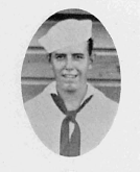 |
S1c Robert Alfred Geer was killed in action at Iwo Jim during the initial invasion on 19 February 1945. He served with the 133rd Naval Construction Battalion. Geer was buried at the 4th Marine Division Cemetery, Iwo Jima and reinterred at Pachaug Cemetery in Griswold, Connecticut. He is memorialized at The National Iwo Jima Memorial Monument and Park in Newington, Connecticut. He was posthumously awarded the Purple Heart, Navy Unit Commendation for the Battle of Iwo Jima, and was entitled to the American Defense Service Medal, World War II Victory Medal, and Asiatic–Pacific Campaign Medal. |
 |
MM1c Thomas Howard Gilbert was killed in action at Iwo Jima when a truck he was being transported in struck a land mine. He served with the 106th Naval Construction Battalion. Howard was buried at the 4th Marine Division Cemetery, Iwo Jima and reinterred at was buried at the 4th Marine Division Cemetery, Iwo Jima and reinterred at Calvary Cemetery, Lorain, Ohio. He was posthumously awarded the Purple Heart, Navy Unit Commendation for the Battle of Iwo Jima, and was entitled to the American Defense Service Medal, World War II Victory Medal, and Asiatic–Pacific Campaign Medal. |
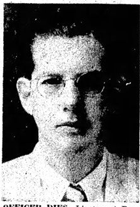 |
LT Roy D. Gilbert died while a prisoner of war at Cabanatuan, Philippines on 29 September 1942. On 6 May 1942, he was reported as "Missing in Action" and was later determined to be a Prisoner of War of the Japanese. He briefly escaped his Japanese captors in September 1942. On 29 September 1942, he was recaptured and executed at the Japanese POW camp at Cabanatuan, Philippines. Commissioned as a Lieutenant CEC-V(S) in the US Naval Reserve on 5 December 1938, and on 20 February 1941 was ordered to the 16th Naval District, Cavite, Philippines for active duty. He received a Letter of Commendation with Ribbon from the SECNAV for his "valuable and outstanding service" rendered in the Philippines area prior to the Japanese attack in December 1941 in overcoming the handicaps of primitive equipment and unskilled labor and showing ingenuity and industry in construction work. Gilbert was awarded the Legion of Merit "For exceptionally meritorious conduct in the performance of outstanding services to the Government of the United States in the defense of Bataan Peninsula during the period from November 5, 1941 to March 11, 1942..." The citation states that he "accomplished the task of building up the Section Base at Marivales and of keeping operative the installations in the rear areas in spite of the repeated destruction of his work at the hands of enemy Japanese forces." He was posthumously awarded the Prisoner of War Medal, Purple Heart, and entitled to the American Defense Service Medal, the Asiatic- Pacific Campaign Medal, WWII Victory Medal and the Philippines Defense Ribbon. Read more at: https://www.history.navy.mil/content/history/museums/seabee/explore/civil-engineer-corps-history/civil-engineer-corps-prisoners-of-war--world-war-ii-.html |
 |
EM1c Edgar Gillham was killed in action at Iwo Jima when a truck he was being transported in struck a land mine He served with the 106th Naval Construction Battalion. Gillham was buried at the 4th Marine Division Cemetery, Iwo Jima and reinterred at was buried at the 4th Marine Division Cemetery, Iwo Jima and reinterred at Saint Mary's Cemetery, Fort Mitchell, Kentucky. He was posthumously awarded the Purple Heart, Navy Unit Commendation for the Battle of Iwo Jima, and was entitled to the American Defense Service Medal, World War II Victory Medal, and Asiatic–Pacific Campaign Medal. |
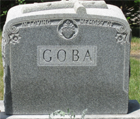 |
S1c Algert Joseph Goba was killed in action aboard LST-333 off the coast of Algeria on 22 June 1943 while serving with the 70th Naval Construction Battalion. In preparation for the invasion of Sicily, LST-333 was performing maneuvers when it was struck by U-boat U-593. The torpedo that struck LST-333 killed 25 crewmen including Algert Goba who was 22 years old. Goba was buried at American Cemetery, Constantine, Algeria, and reinterred at Highland Cemetery, Norwood, Massachusetts. He was posthumously awarded the Purple Heart, was entitled to the American Defense Service Medal, World War II Victory Medal, and European–African–Middle Eastern Campaign Medal. |
 |
S2c Roy A. Goldberg was killed in action on Stirling Island during the Treasury Islands invasion while deployed with the 87th Naval Construction Battalion. On 14 January 1944, a Japanese dive bomber attacked the airfield and S2c Roy Goldberg was killed in action. S2c Goldberg was interned in the cemetery at Filami Village, Mono Island and later reburied at Union Cemetery in Hellertown, Pennsylvania. He was posthumously awarded the Purple Heart, World War II Victory Medal, and Asiatic–Pacific Campaign Medal. |
 |
LT Benjamin Goodier died while a Japanese prisoner of war on 26 January 1945. In 1934, the Goodier family travelled to Manila where he investigated coal, chromite and manganese possibilities in the Philippines. He was a veteran of WWI and when the country entered WWII, as a Naval Reserve Officer, he was called back to active duty in 1939 as part of the Civil Engineer Corps. On 2 January 1941, Goodier reported to the 16th Naval District, Cavite, Philippines for duty. Following the Japanese attack and invasion of the Philippines in December 1941, Goodier was taken prisoner and detained with his family at the Santo Tomas interment camp on 10 January 1942. He was then taken to Intramuros prison before being transferred to Cabanatuan prison. He and two other Civil Engineer Corps officers were placed aboard the ship Oryoku Maru in December 1944 for transfer as prisoners to Japan. U.S. aircraft sank the ship before it could leave the Philippines. The surviving POWs, including Lt. Goodier, were transferred to another ship, the Enoura Maru which made it as far as Formosa (Taiwan) before it too was sunk. The remaining POWs were transferred to yet a third ship and completed the voyage to Japan.The death date for those POWs who died at Formosa (Taiwan) is 12 January 1945. The death date for Lt. Goodier on the 3rd ship dying shortly before reaching Japan is 26 January 1945. The death date carved on the headstone is 26 January 1945. Lt. Goodier is commemorated at several places: at the National Memorial Cemetery of the Pacific in Hawaii, where he is listed as "Missing in Action (died Prisoner of War) Row #78, Column #4, Panel #3; in the Philippines at the Manila American Cemetery and Memorial; and in Colorado at Fort Logan National Cemetery, Denver. LT Goodier was posthumously awarded the Purple Heart for wounds received in action, and entitled to the American Defense Service Medal, the Asiatic- Pacific Campaign Medal, WWII Victory Medal and the Philippines Defense Ribbon. The Goodier family was interred at Santo Tomas from January 1942 to 23 February 1945. Also living in the Philippines at the time were his brother George and family and their sister Florence Goodier Carlson, all also interred at Santo Tomas. |
 |
S1c Robert Goodman was killed in action from a wounds received from enemy gunshot at Agana, Guam on 4 September 1944. He served with Construction Battalion Maintenance Unit 515. Goodman was buried at the Army, Navy & Marine Cemetery, Guam and reinterred at Cambridge Cemetery, Cambridge, Middlesex County, Massachusetts. He was posthumously awarded the Purple Heart, was entitled to the American Defense Service Medal, World War II Victory Medal, and Asiatic–Pacific Campaign Medal. |
 |
CM2c Victor Goodspeed, a member of the 19th Naval Construction Battalion deployed to New Britain Island, was killed in action on 17 January 1944 of wounds received after shrapnel from enemy bomb hit his head and left shoulder. He was buried at US Armed Forces Cemetery, Cape Gloucester, No. 1, New Britain and reburied at Franklin Cemetery, Vienna, Maine. He was posthumously awarded the Purple Heart, World War II Victory Medal, and Asiatic–Pacific Campaign Medal. |
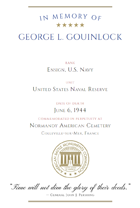 |
ENS George Gouinlock, CEC, was killed in action at Omaha Beach, Normandy on 6 June 1944 while serving with Naval Combat Demolition Unit 41. He was buried at Normandy American Cemetery American Cemetery, France. He was posthumously awarded the Presidential Unit Citation and Purple Heart, was entitled to the American Defense Service Medal, World War II Victory Medal, and European–African–Middle Eastern Campaign Medal. |
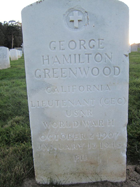 |
LT George Greenwood was killed during a bombing attack on the ENOURA MARU, a Japanese Prisoner of War ship in Takao Harbor, Formosa on 13 January 1945. On 5 August 1937, Greenwood accepted appointment as an Assistant Civil Engineer with the rank of Lieutenant (junior grade) in the CEC of the US Naval Reserve. Called to active duty, he reported to the 16th Naval District at Cavite, Philippines. Serving at the 16 ND HQ when the Japanese attacked Cavite on 8 December 1941. He was reported to be a prisoner of war on 23 February 1943. He was killed in action in Takao Harbor, Formosa, in a bombing attack on the ENOURA MARU, a Japanese prisoner of war ship on 13 January 1945. He was buried with a group of 344 POWs, he was later identified and placed in US Army Mausoleum #2 at Shanghai, China. He was later moved to Shofield Barrack and then reinterred at San Francisco National Cemetery on 15 July 1949. LT Greenwood was awarded a Letter of Commendation, with Ribbon by the Secretary of the Navy, "For outstanding service while serving in the Public Works Department of the Cavite Navy Yard...during the bombing attack by enemy Japanese forces on December 10, 1941. Placed in charge of transportation, with the one or two trucks still undamaged by bombing or fire, you skillfully supervised the routing, repair, and continued operation of automobiles and trucks carrying out this task under the most difficult and hazardous conditions. In addition, you rendered invaluable assistance in evacuating aviation personnel, enabling them to proceed with the Fleet. For exemplary conduct throughout this period of grave stress, you are hereby commended." In addition to the Commendation Ribbon, he was awarded the Prisoner of War Medal, Purple Heart Medals, American Defense Service, Asiatic-Pacific Campaign, and the WWII Victory Medals. |
 |
CM3c Billy Joe Grim was killed in action from wounds received as a result of enemy bombing at Iwo Jima on 1 June 1945. He served with the 90th Naval Construction Battalion. Grim was buried at the 4th Marine Division Cemetery, Iwo Jima, and reinterred at Fairlawn Cemetery in Elk City, Oklahoma. He was posthumously awarded the Purple Heart, Navy Unit Commendation for the Battle of Iwo Jima, and was entitled to the American Defense Service Medal, World War II Victory Medal, and Asiatic–Pacific Campaign Medal. |
 |
MM3c Maurice Grindstaff was killed in action at Okinawa on 24 July 1945 while serving with the 13th Naval Construction Battalion. He was buried at and reinterred at Veterans Liberty Cemetery, Fresno, California. He was posthumously awarded the Purple Heart, was entitled to the American Defense Service Medal, World War II Victory Medal, and Asiatic–Pacific Campaign Medal. |
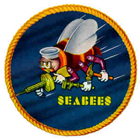 |
MMS1c Thomas Mulligan Grove was killed in action after receiving wounds as a result of enemy action. He served with the 31st NCB. Grove was buried in the 5th Marine Division Cemetery, Iwo Jima and reinterred at Oak Ridge Cemetery in Altoona, Pennsylvania. |
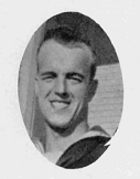 |
S1c John Bernard Grudzina was killed in action during the initial invasion at Iwo Jima on 19 February 1945. He served with the 133rd Naval Construction Battalion. Grudzina was buried at the 4th Marine Division Cemetery, Iwo Jima and reinterred at Saint Adalberts Cemetery in Milwaukee, Wisconsin. He was posthumously awarded the Purple Heart, Navy Unit Commendation for the Battle of Iwo Jima, and was entitled to the American Defense Service Medal, World War II Victory Medal, and Asiatic–Pacific Campaign Medal.was killed in action during the initial invasion at Iwo Jima on 19 February 1945. He served with the 133rd Naval Construction Battalion. Grudzina was buried at the 4th Marine Division Cemetery, Iwo Jima and reinterred at Saint Adalberts Cemetery in Milwaukee, Wisconsin. He was posthumously awarded the Purple Heart, Navy Unit Commendation for the Battle of Iwo Jima, and was entitled to the American Defense Service Medal, World War II Victory Medal, and Asiatic–Pacific Campaign Medal. |
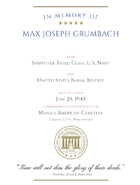 |
SF3c Max Grumbach was killed in action in raid on Rendova when an bomb exploded ten feet from his foxhole on 25 July 1943. He served with the 24th Naval Construction Battalion. Grumbach was buried at Cemetery #1, Rendova and reinterred at Manila American Cemetery and Memorial, Manila, Capital District, National Capital Region, Philippines. He was posthumously awarded the Purple Heart, was entitled to the American Defense Service Medal, World War II Victory Medal, and Asiatic–Pacific Campaign Medal. |


